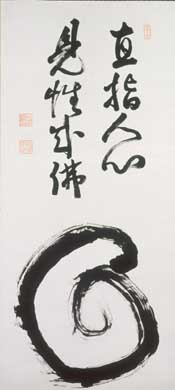| architecture |
| calligraphy |
| ceramics |
| clothing |
| comics |
| gardens |
| lacquerwork |
| literature |
| movies |
| music |
| painting |
| poetry |
| sculpture |
| tea ceremony |
| television |
| theatre |
| weaponry |
| thematic routes |
| timeline |
| the site |
context: painting > Zen painting > Subjects

|
The great founder of Zen, by the Zen priest Shoun |
Daruma
The priest who supposedly carried Zen from India to China in the 6th Century was Boddhidharma, known in Japan as Daruma. He was the first patriarch, and has been the single most popular Zen painting subject ever since. This is one of those categories of Zen art where it's very hard to understand the point of a particular image, other than as a devotional icon, without being able to read the all but inevitable inscription, a koan or haiku pointing towards some Zen idea. Nevertheless, a couple of unusual traditional attributes of Daruma imagery are worth highlighting.
Firstly, the wide staring eyes, that don't look very Japanese, are usually explained by stories of Daruma ripping off his eyelids to make it less likely that he would fall asleep during epic meditation lessons. I'd have thought that his Indian, therefore caucasian, racial background might be a more likely explanation, but that loses some strong mythologising, of course.
Secondly, he apparently spent nine years in a cave continually staring at a wall, meditating. This is a common image in itself, but an extension is that his legs atrophied and fell off during this time, so you rarely get a glimpse of his legs, though I don't think I've seen a painted image where he clearly lacks legs - I suspect the artists don't want to contradict even a pretty stupid story, but on the other hand don't want to paint something so farcical. Although there are two counts against that last notion: you can buy little wooden toys of Daruma, built on the Weeble principle; and the fierce Zen priest Nantembo invented a new twist called a Snow Daruma; so maybe it's gone beyond worrying about the dignity of this great religious figure.
The kind of painting known as ippitsu, one-stroke, where the entire image is drawn after dipping the brush once, in one continuous movement, has been particularly tied to the depiction of Daruma facing the wall of the cave - he's in a robe, seated, his back to us; this image is known as menpeki Daruma, and includes many of the weirdest paintings of revered and holy forefathers the world has ever produced, as seen on this page and the bonus link to my favourite artist on this subject:
